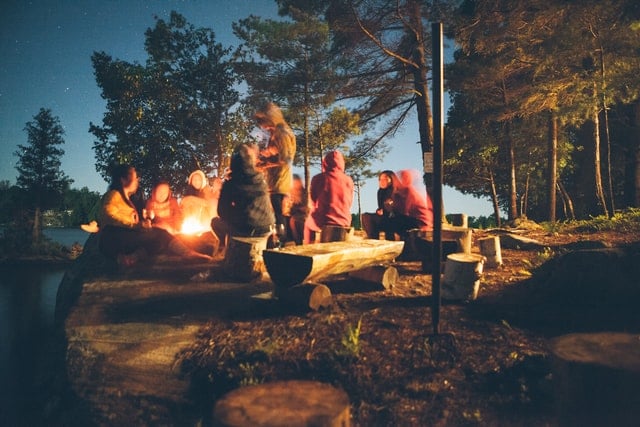This is a deep topic. It is the purpose of many people’s life’s work. It is controversial. It is personal. But isn’t it exciting to think that we might improve at learning? Isn’t it the wish for more wishes?
 For the purposes of Circles, we have synthesized a bunch of big ideas around learning into a “framework.” This is intended to orient learners to all the skills they might develop. It is intended to guide us to areas where we can develop richer course content and practices.
For the purposes of Circles, we have synthesized a bunch of big ideas around learning into a “framework.” This is intended to orient learners to all the skills they might develop. It is intended to guide us to areas where we can develop richer course content and practices.
Below is a crude start. The plan is to shape this into a 20-minute overview – a series of “drops” and meeting exploration questions in time for our first trials. I expect we’ll hone it and add depth and cogency for years to come.
1. Visualize
Start with the end.
A year after I left M5, I returned to talk with my former learning department about what they had learned about learning. Emphatically, they said: it is all about the “badge.” This puzzled me. Badges are new jargon for credentials. The idea is that when someone learns a new skill, they are recognized for it by their instructor or by their peers. They collect badges like a Scout.
Is this about building an internal or external resume? Studies have shown that the “brand” of a credential is about 35% of its economic value (the rest being the actual utility of the skills learned) so it isn’t a surprise that this is an important part. But for many learning programs it is a trap – students are more interested in obtaining the degree than learning the material. So, while important, I’m less interested in the marketplace for badges, per se.
Or maybe their comment could be all about the power of positive feedback? The business classic,
But the reason badging is number one on my list is not about bragging rights or feeling good about progress. If you can’t badge it, you can’t teach it! This is the only way to be clear about WHAT you are teaching. How do you know if a student put in hours or received an outcome?
And this is a big issue with education today. The system runs on credit-hours. A learner puts their time in and the program marches on whether or not they’ve mastered the material. Clay Christiansen, Sal Khan and others have focused on this – what they call “competency-based learning.” It is the same at work. M5 was training people without really being clear on what they were hoping students would be able to do after the training. And while I welcome the flood of new startups into the education space, many of them have the same issue – lots of people buy and start these programs, but few leave changed.
If the system of education-to-employment really became about competency instead of completion, hiring might be greatly improved. A study by the group Innovate-Educate in New Mexico found that only 1% of unemployed 16-24 year olds had a college degree, but 33% tested with the skills of a degree. A previously invisible talent pool? Similarly, 50+% of employers, depending on the study, complain their employees don’t have promised skills.
I thought about using only the word “visualize” instead of “badge.” What I’m talking about is where you envision exactly what success means in completing a learning program. We know that visualization in and of itself is a powerful learning tool and a motivator. See the ignite section below. In fact, if you can define the goal clearly enough, you bother a lot less with the steps to get there. Students will find their own way. After all, they now have massive access to information, courses, teachers and stories. And the paths may be surprising. For example, a 2007 study found that surgeons who played video games 3 or more hours a week made 37% fewer errors in laparoscopic surgery. Things that make you go … “hmmmmm.”
2. Map
Learners don’t get anywhere in one leap. This is where the idea of a “skills map” helps. Can you break the ultimate skill down into subordinate ones? Can you assess competency with each sub-skill and reward learners along the way?
Advanced skills breakdown into fundamental skills, in almost infinite recursion:
There are some sub-skills in common to many super-skills. I call the most common sub-skills “fundamental skills.” Communicating effectively, or collaborating in teams, might be considered fundamental sub-skills to super-skills like managing, selling and many other things. One of my challenges is that you have to get really granular in order to make any of these skills really assessable, teachable, or actionable in a meaningful way. “Collaborating” is way too vague, for example.
Clearly defining and communicating the “what” that you are teaching is a true art. It is hard. This is one place where you can imagine a true learning scientist earning her stripes. In fact, several modern learning projects separate the curriculum design experts from the instructors – more on that later. Anyway, a few scattered comments about this step:
While you need to understand your material deeply to set learning objectives, this very mastery can blind you to the challenges a new student experiences. Eric Masur, a pedagogy innovator, recommends using wrong answers on tests to construct the learning map, because that is a good way to see where students have gaps and challenges. Sal Khan’s book The One World Schoolhouse: Education Reimagined and of course, his implementation at Khan Academy, emphasize the idea that real trouble comes from missing a fundamental skill along the way. He asserts that classes that move along before a kid masters a fundamental skill is why kids sometimes wash out of subjects like math, for example.
Tim Ferris appears to be a genius at dissecting skills into maps. His schtick is that to get this right you dissect the sub-skills that have the most impact, strip away the rest and then sequence properly. You can basically hack any skill and “become world-class in six months or less.” He’s got a TV show where he does this with a different skill each week. I recommend his chapter on “meta learning” in The Four-Hour Chef. I have found his approach to language learning effective with my Spanish, but it is certainly not the approach of my Spanish school.
My friend and hero, world chess and martial arts champion Josh Waitzkin, picked a fight with Tim. He argues that shortcuts undermine long-term mastery. Tim’s maps gets you to competency fast, but leave you with cracks in the foundation. Still, Josh extensively uses maps. His story in The Art of Learning about how in learning to play chess he first mastered the simple end-game with kings and pawns only, whereas most kids learned flashy openings, underscores this point vividly.
I’m exploring different forms of defining and communicating skills objectives, and it is clear that there is no standard and a ton of work to do. Not sure what format to advise, other than to get students to visualize in great detail, or watch, the target skill.
Beware unintended consequences. Dan Pink’s book Drive or Stephen Dubner’s Freakonomics series illustrate graphic stories of unintended consequences of botched goal definition is also botched. It frequently is.
One concept I love in mapping is what famous dead-guy Randy Pausch calls the “head-fake” in his moving last lecture. That is to say, your course is really about something besides it’s stated goals. Most college courses are this – you might be learning economics but really you are learning how to make a logical argument. Very cool with me, as long as it isn’t some weak after-the-fact rationalization but is an explicit intention.
The learners also need to construct maps. We learn by connecting new information to old. The biological process is literally wiring neurons together. So, students need to be constantly constructing mental models of the new information, anchored in what they already know. I return to this idea talking about rewiring.
John Cone, former chairman of ATSD and head of learning at DELL, believes the single biggest issue with education is that it is linear. We don’t think that way. Chunking concepts into small bits (popularly 3-5 minute videos) that are available whenever the learner needs them is all the rage.
This touches on the massive topic of “what” to learn. Not all skills are created equal. Circles uses a framework for classifying knowledge, skills, and character traits developed by Charles Fadel, author of “21st Century Skills” and “4 Dimensional Learning.” We will look at that another day.
3. Assess
If you can visualize and describe your outcomes, if you have made a map, then you should be able to tell if someone is doing the desired skill correctly or not. You know what to test. But this is maybe the hardest part. Learners are notoriously bad at assessing themselves. The famous quip is to cite the study in which 80% of people rate themselves as above-average drivers. We often mistake the pleasant feeling of passive understanding for active ability, and move on too soon. Plus, most things are really hard to assess automatically and objectively. So assessment might be the most important and difficult role for a teacher or coach.
But there are some new ideas about testing.
At the turn of the last century, the traditional who-you-know system of admitting people into a university broke down. Mass demand forced schools to develop grades and standardized tests to sort people at scale. That’s a very different proposition with a different purpose besides educating.
So when we test is itself backwards. Testing at the end is not that useful – it is too late. Whatcha gonna do with a learner that didn’t grasp something? Besides, the cramming that “summative” testing inspires is a lousy learning strategy. Test upfront, so you can adjust for who you’ve got in the group. Or deselect people that won’t benefit because they are starting too far behind or ahead.
But it is an even better idea to test during the class. Quiz. Why? First, it maximizes engagement and keeps people’s attention. Second, the teacher and class get immediate feedback on what’s going right or wrong. You can avoid moving ahead and leaving gaps that will ultimately frustrate or defeat learners. But most importantly it dramatically improves outcomes. When people have to actively engage instead of passively soak in, they build durable neural pathways faster. Make it Stick offers many examples and empirical studies of “the testing effect.” Kids that are regularly quizzed perform more than a full grade higher. Retrieval is learning.
By the way, you can quiz using the socratic method – call on people constantly. But we’ve got the technology for fully engaging the whole class now. One compelling example is Eric Masur’s “Peer Instruction” a process he invented while teaching physics at Harvard, which he describes and demonstrates in this video. Another favorite of mine is the innovative classroom designed by the Minerva Project, an attempt to compete with the top Ivy-League colleges, which Stephen Rosslyn, Minerva’s academic dean, describes in this recent talk.
There’s an even more important change in our approach to testing. Not only were we testing at the wrong time, THE WRONG PERSON IS TESTING. The highest goal should be to teach students to self-assess. This isn’t easy, of course, as we are notoriously bad about assessing ourselves. But if you can accomplish this – showing people techniques for constantly checking their work, you will have students on the way to true mastery. I believe that this is amongst the reasons why teaching is one of the best ways to learn. Mazur’s Peer Instruction goes a long way to accomplishing this. And, ultimately, this is one of the most important learning or “metacognition” skills, as I mention below.
So, “formative” assessments are more useful by far than “summative” assessments, for the purpose of learning. The ultimate is what Doug Lynch calls “Enders Game learning” – is it training? A test? Real?
4. Ignite
You can’t be sure of what you start with. Are students high-will, driven, self-motivated? Are they determined to learn? It is a safe bet that most students are not “on fire” to change. People fear change, even if they say otherwise. For me, this fear is captured by the ancient story of the Ship of Theseus, dramatically retold recently by JJ Abrams in the haunting novel,
So it helps to think about what will ignite a learner at the outset to get them moving fast and autonomously. In The Talent Code, author Dan Coyle describes places around the world that are unique hotspots for superstars – (women golfers from South Korea, baseball players from the Dominican Republic, singers from Dallas, artists from medieval Florence, etc.). He labels a phenomenon called “ignition” when someone sees that something is possible, and decides that they could do it, too. A clear example is how after Roger Bannister broke the 4-minute mile in 1954, ten others did it within the same year. To ignite someone, they need to see the story of someone like them and what they accomplished. Coyle’s advice to learners: “Stare at who you want to become.” You might help learners act on this with testimonials, videos, or live introductions.
There is a lot we can do to help get someone moving. Switch is one of the best books about how to change behavior that I’ve seen. Its central metaphor sticks with me: a man is riding an elephant down a path. The rider is reason, the elephant is emotion and the path – the path to change. You need to address all three. Logic might get you to set the alarm clock, emotion is needed to haul your ass out of bed, and it helps a lot if the gym is steps away from your house. (I love Seinfeld’s night-guy vs. morning-guy bit).
There’s clearly art here. Some teachers that I have spoken with talk a lot about how critical it is to find and tap each learner’s motivation. Are they interested on a practical or theoretical or even spiritual level? Do they look at the subject matter as technical or a chance for creative expression? Herein might be the challenge of igniting someone – finding their passion.
The great news for learning businesses is that “ignition” is your sales and marketing. But it goes beyond that. Learning programs, like all sales really, can fall victim to buyer’s remorse. Your students may need to be fired up again, especially if it is a long time since that moment they clicked to “confirm the order.”
5. Commit
This is a problem with both learners and educators. Learners think they should show up and get taught, particularly if it is job-related. Supervisors have better things to do besides teach. I wrote about the reluctance of M5’s managers to make time for our music program. More often than not, the daily grind defeats learning plans.
But there’s no way around it, learners have to commit. They have to put things aside. They have to show up They have to do homework. If you’ve been in the workforce for more than 12 minutes, you know that people in general aren’t great at keeping new, non-urgent commitments. Blame it on time management, self-discipline, focus, habits, the pressures of adulthood — it wasn’t easy to study in college, but grownups have an even harder time “making time.” Educators that care can’t hide from this fact. We have to design for it. One way is to minimize the commitment required. But here’s a few other ways:
Analyze the points where people usually quit. Address them. McKinsey’s team told me how they are doing exactly that as they create boot camps to ramp underemployed youth into hard-to-hire jobs. Their teams observed the jobs for a few days, and collected data about why people quit or fail. Then they prioritized these failure points in their ambitious “Generation” training programs. Tim Ferriss gives the example of pushing grammar rules way later in learning language, focusing instead on giving some early wins. At WIBO, we saw our biggest drop-out around the two financial modules of our 16-week workshop, so we implemented a process of having coaches check in actively during those weeks.
StickK is a book and website about applying the principle of promise-keeping by adding stakes and a referee. And, by the way, anti-stakes like donating money to a cause you hate if you fail, work best. (The George W. Bush Memorial Library is tracking as the #1 anti-charity on the site.)
Acknowledge that we are terrible observers of our own learning. Satisfaction may be few and far between. Encourage. Prepare for the long plateaus between inspiring rushes of new material. Understand why Disney deliberately designs queues to feel like they are always moving forward.
Avoid the shame-spiral by acknowledging that this happens upfront and give people multiple chances to catch up if they fall behind. Have a Plan B available when people miss a promise or mess up, like having restaurant delivery on speed-dial while trying to cook a new dish.
Don’t be afraid to drop some reminders of what ignited them to begin with.
6. Team
Lectures are the way most teaching has gone since books were scarce. As Masur quotes, “A lecture is a process in which the teacher’s notes are transmitted to the student’s notebooks without passing through the brains of either.” I think they’ve persisted because they are an efficient way to teach, albeit a crappy way to learn.
So, the big new innovation here is “flipping” the classroom. Imbibe the material, either in a book or a video or both, at your own pace, at home. Work with the material in the classroom, with peers. This has many benefits, but is relatively new and we have much to learn about how to do it well. (1) People stay awake and more engaged. (2) People feel accountable to their peers, getting some of that “StickK” benefit I mention above. But peer learners are closer to the problems a beginner has in learning and demonstrably can help each other more than a professor. It turns out, for example, that practicing a language with people at your own level is considered more productive than speaking with fluent natives.
I’ve seen lots of evidence of this:
- Weight Watchers
- Alcoholics Anonymous
- The Boy Scouts
- MBA classrooms
- Omaha Health, an innovative healthcare provider uses it with groups of patients with diabetes and obesity
- YPO and EO, and so on – all use peer groups as their basic structure for learning.
The key challenges are how to constitute and maintain a highly-functioning peer group. This is not something most administrators or educators pay attention to. At work, you may or may not be starting with a functioning team.
- Co-ontogenic structural coupling. Maturana.
- Inner Tennis. Learning by copying is the most basic way.
- Pick your peers!
7. Flow
What should a great learning experience feel like?
One of my favorite books, Flow describes that nirvana-like state, sometimes called “the zone” when people are arguably at their best. Does your learning experience bring that out? I think these ideas have inspired many people to try to gamify learning, but I think it is useful to think about what exactly it is about games that make them so engaging. I think we’re after the intensity of rock-climbing and not just the addictiveness of Tetris. Mihaly Csikszentmihalyi describes several characteristics of this “zone” state that are worth transferring into learning experience design.
- Clear goals
- A sense of control
- Constant feedback on how you are doing
- Near-total immersion, a feeling of losing oneself
The Talent Code picks up on this idea and describes the state of “deep practice” that superstars achieve – in short, intense bursts of 60-90 minutes with breaks.
I’d add a couple of other points to this that I learned from Scott Weiner, a successful learning professional and hypnotist, who I’ve written about. To summarize it, hypnosis works in part because learning sticks more when you are relaxed, and positive images of “what to do” stick better than negative “what not to do” messages.
I can’t shake the feeling that much of this wave of learning science that I’m learning about is the recovery of long-known but often forgotten wisdom. Vanessa Rodriguez, a researcher at Harvard, is studying the impact of high oxytocin and serotonin levels on learning in classrooms. In other words students will learn more if they trust their environment, their teacher, their peers and well… feel loved. Harvard MBA rockstar professor and guru Clay Christensen has written about how his whole teaching career was turned around when he began to intentionally invoke feelings of love for his students before class.
This poses a particular problem at work, where the trust level is likely to be low. Is work the best place to learn? Here are ideas to explore for achieving the “flow state”:
- A jelled peer group
- Music
- Time – is a flow state like sleep where it takes a little while to deepen?
- Active listening skills
- Physical relaxation
- Mindfulness/meditation
- Beginner’s mind – letting go of judgements
- Positive intelligence
- Humility
- Grit
8. Rewire
It helps to understand a little pop neuroscience. Well, I’d guess it probably helps to understand a lot, and I’m learning more all the time, but a few insights stand out.
Biologically, skills acquisition is building circuits in the brain. Specifically neuronal pathways are wrapped in a substance called myelin. Good practice adds layers of myelin, like insulation on a wire, that improve the speed and accuracy of transmission. Scientists are studying what builds these pathways and what degrades them. Good practice habits can radically cut down the time it takes to build good myelin. The Talent Code and Make it Stick are the two best books I’ve read on this.
Some applicable nuggets:
Deep Practice. Effort builds learning. Struggling with material, engaging with it, filling in gaps. People remember words better when they are missing letters. This kind of intense work can only be sustained for short periods, so it is about the quality and not the length of practice.
Chunk. Break skills down into small chunks and master them.
Spaced Repetition. Building a skill is about interrupting the process of forgetting. The key is to come back to the information right before you are about to forget it. I’ve seen great results with learning Spanish with
Interleave. Because spaced repetition is so important, it is useful to weave concepts throughout a curriculum and keep returning to the important ones.
Mistakes Are Important. This is crucial to learning. Learning environments must encourage people to be open about them. Expert learners seize on their mistakes zealously.
Build Mental Models. Neural pathways connect to existing chunks of information. Using metaphors and comparisons and regurgitating information in learner’s own words is learning.
Nap. It takes time for these pathways to bake. Maybe 24 hours, maybe more. Sleep helps.
Slow it Down. Pathways can be built at slow speeds as effectively as quickly. Great practitioners share this.
Touch Quality. Repeating things incorrectly builds incorrect pathways. It is much better to go very slow, with a very small chunk.
Reflect. Reflection is another great learning practice. It is a way to engage with the material, building pathways and links to other experiences.
Teach. Teaching a topic is one of the best ways to learn it.
Debunking Theories. There’s a lot of bunky learning theories out there, maybe including some of the ones I’m writing about. A very popular theory suggests that some people learn better visually, or kinesthetically, or aurally – this seems to have been debunked. The prevailing theory is that people benefit from a combination of all three. See the book Make it Stick for more on this. Our schools are very focused on the verbal like lectures, tests, written assignments and reading; but they’re leaving a lot on the table.
Loading memory. A few thoughts on this…
- The whole idea of mnemonics is a practice using this principle. My own experience is that the initial mnemonic can be ridiculous, but it gets the job done, and will eventually fade away
- Elaboration is a related concept. Metaphors are an example of this. Elaboration is most powerful when done by the learner… “What does this remind you of?”
- Generation is a term for predicting the information before learning it. Again, another trick for rewiring the brain and keeping it working. You see this used very commonly in lectures, lamely trying to get all those audience brains engaged.
Stories. This is one of the most ancient and powerful ways of transmitting information. Is your material, or your experience, in narrative format? Is there an exposition, a conflict, a rising action, a resolution and a denouement? These parts don’t have to be in order.
Can old people learn? It is true that after middle-age we build neural pathways less efficiently. But the impact is slight and other mature abilities compensate.
Dan Coyle published another great short book that is particularly useful for coaches, The Little Book of Talent: 52 Tips for Improving Your Skills. It’s a good cheat sheet as well.
9. Coach
If you accept the above points, the role of a teacher changes. I’m considering a bet on an economic models leverages this, avoiding the need for full-time faculty that are expert in a subject. Perhaps you need a learning scientist paired with a subject-matter expert to design a program, and an instructor on the field to help the learners make their way through. This person looks more like a coach, and by the way, might even be a peer. I’m not discounting the value of a coach, but I do think it is a different skill.
Some of the principles above apply to designing the experience. But I’d argue that a coach really needs to be good at continually assessing, because learners are bad at self-assessing and this is notoriously hard to automate. Secondly, they need to tune the experience, helping the learner stay in “flow.” There are good coaching gems in
10. Roll
The mantra of “experiential learning” is one of the most common I’ve seen in recent literature. This idea is often traced to Maria Montessori 150 years ago. It is certainly the mantra for adult education scholars today. You have to connect the learning to real experiences, and to things that matter, for it to be “authentic.”
The trick here is safety. Making mistakes is essential to the learning process. And learning proceeds according to a usual process – where the intermediate stages are characterized by disorientation and frustrating mistakes as the learner assimilates new information. (On The Internet has a good essay about this in chapter two.) But fuck it. There are so many examples of this going well – check out the stories in Kio Stark’s Don’t Go Back To School or any of the “education hacking” stuff.
This is especially true of “soft skills.”
Here I like to dream a bit about mobility, wearable devices and the general idea of integrating a learning experience into someone’s daily life. Giuseppe Auricchio calls it “omni learning.” Everwise describes its missions as getting you to learn while doing what you were going to do anyway. Sebastian Barajas wrote a book called Aprender es Hacer on this point.
 The best tech initiatives this year have served as an aid, helping enhance our lives rather than distracting us from them. We’ve seen VR that helps the visually impaired see, a new form of renewable energy harnessing the ocean’s waves, incredible lifelike prosthetics.
The best tech initiatives this year have served as an aid, helping enhance our lives rather than distracting us from them. We’ve seen VR that helps the visually impaired see, a new form of renewable energy harnessing the ocean’s waves, incredible lifelike prosthetics.





 For the purposes of Circles, we have synthesized a bunch of big ideas around learning into a “framework.” This is intended to orient learners to all the skills they might develop. It is intended to guide us to areas where we can develop richer course content and practices.
For the purposes of Circles, we have synthesized a bunch of big ideas around learning into a “framework.” This is intended to orient learners to all the skills they might develop. It is intended to guide us to areas where we can develop richer course content and practices.